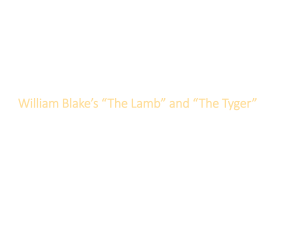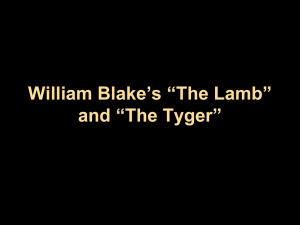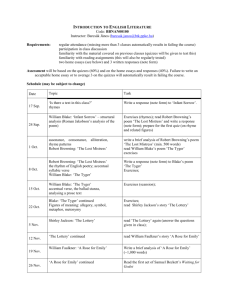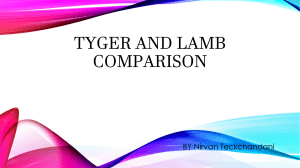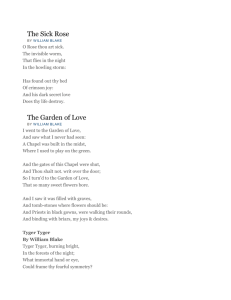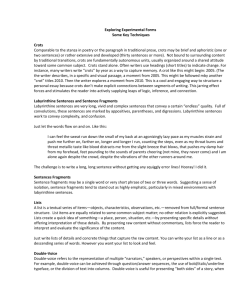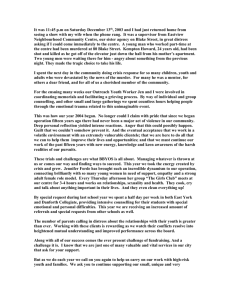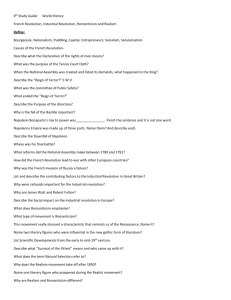The Tyger
advertisement
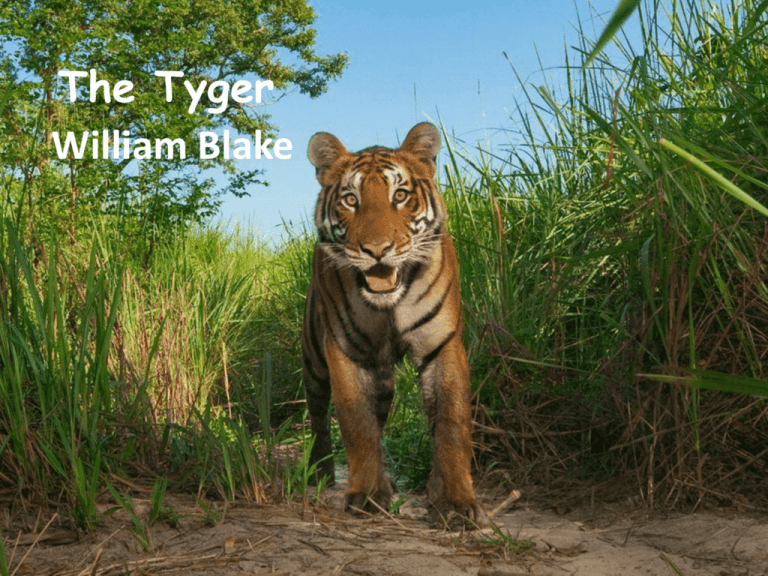
The Tyger William Blake William Blake Genre: Poetry Style: Romanticism Influences: 1. Bible 2. Ideals and ambitions of American and French revolutions 3. Philosophers Jakob Böhme and Emanuel Swedenborg Influenced: Beat poets of the 1950s and the counterculture of the 1960s Romanticism: Intuition, Imagination, and Feeling • • • Romanticism (or the Romantic Era) was a complex artistic, literary and intellectual movement that originated in the second half of the 18th century in Europe and gained strength in reaction to the Industrial Revolution. In part, it was a revolt against aristocratic social and political norms of the Age of Enlightenment and a reaction against the scientific rationalization of nature. The movement validated strong emotion as an authentic source of aesthetic experience, placing new emphasis on such emotions as trepidation, horror and terror and awe. It elevated folk art and ancient custom to something noble, made of spontaneity a desirable character and argued for a "natural" epistemology of human activities as conditioned by nature in the form of language and customary usage. Romanticism reached beyond the rational and Classicist ideal models to elevate a revived medievalism and elements of art and narrative perceived to be authentically medieval, in an attempt to escape the confines of population growth, urban sprawl, and industrialism, and it also attempted to embrace the exotic, unfamiliar, and distant in modes more authentic than Rococo chininoiserie, harnessing the power of the imagination to envision and to escape. Social Conditions Revolution: Just before the Romantic Era, the American Revolution had occurred, and the French Revolution was taking place. The American Revolution not only cost England economically, but also it lead to a loss of prestige and confidence. The French Revolution resulted in the a democratic mob overthrowing an anointed king. It meant the triumph of radical principles, which the ruling class and the wealthy feared would spread to England. As a result, English conservatives instituted severe, repressive measures. For example, collective bargaining was outlawed, and suspected spies could be imprisoned without a trial. Industrial Revolution: Land was no longer communally owned, resulting in many landless people. Consequently, many people moved to cities to seek charity or to work in factories, where machines replaced artisans to manufacture what had previously been handmade. Women and children made up 75% of the factory workforce. Children as young as five were often forced into the factories to help earn enough for their families to survive. Living conditions were very poor for the common man. Working families often lived in slums with little sanitation, and infant mortality skyrocketed. During the early Industrial Revolution, 50% of infants died before the age of two Laissez faire (term meaning that the government should leave the market to its own devices and should not interfere with the economy): This allowed wealthy, middle-class owners to pursue whatever path was most profitable, regardless of the safety and wellbeing of their workers. The relentless pursuit of profit lead to another major social change: the ultimate breakdown of the family unit. Since workers, especially women and children, were laboring for up to 18 hours each day, there was very little family contact, and the only time that one was at home was spent sleeping. People also had to share housing with other families, which further contributed to the breakdown of the family unit. As a result, children received very little education, had stunted growth, and were sickly. They also grew up quite maladjusted, having never been taught how to behave properly. The Tyger • “The Tyger,” along with “The Lamb,” first appeared in a collection of poems entitled Songs of Innocence in 1789. In 1794, Blake combined these poems with a section entitled Songs of Experience. Blake called the combined edition Songs of Innocence and of Experience: Shewing the Two Contrary States of the Human Soul. Twelve years later, Blake added a final poem, “To Tirzah,” at the end of the collection. It summarizes the entire work. The poems were written to be sung. However, Blake’s original melody is now lost. Blake’s illustration of “The Tyger” The Tyger Missing Lines When the stars threw down their spears, And water'd heaven with their tears, Did He smile His work to see? Did He who made the lamb make thee? The Tyger Poetic Structure • Rhyme Scheme AA BB CC DD EE FF GG HH • Meter trochaic tetrameter with catalexis at the end of each line • The poem consists of six quatrains. (A quatrain is a four-line stanza.) Each quatrain contains two couplets. (A couplet is a pair of rhyming lines). Thus we have a 24-line poem with 12 couplets and six stanzas. The question in the final stanza repeats (except for one word, dare) the wording of the first stanza, perhaps suggesting that the question Blake raises will continue to perplex thinkers ad infinitum. The Tyger Analysis • Symbols 1. The tiger: Evil or Satan 2. Distant deeps: Hell 3. Skies: Heaven 4. Lamb: Goodness • Question 1. Who created evil? 2. If God is responsible for making both good (the lamb) and evil (the tiger), how can God be good and moral? (If read in conjunction with “The Tiger”)
